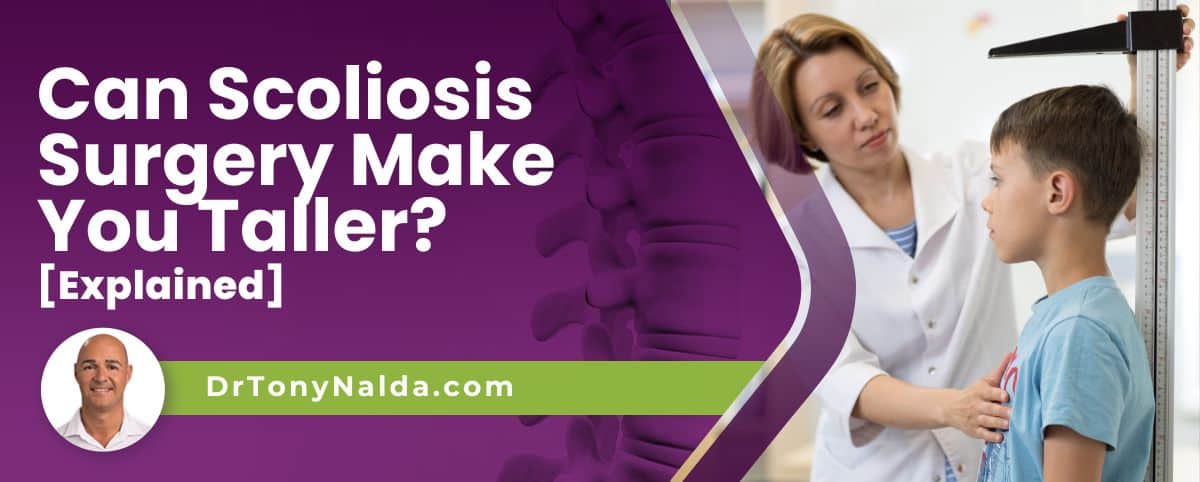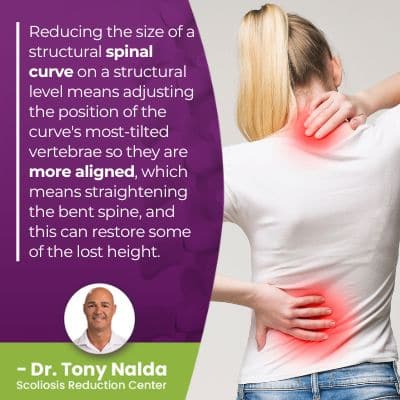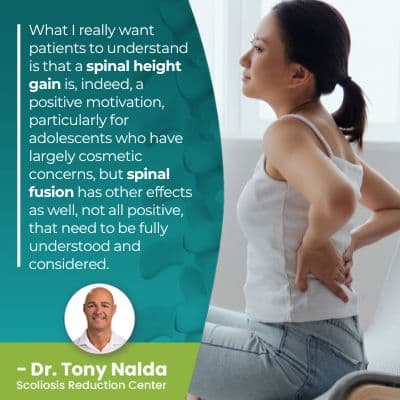Can Scoliosis Surgery Make You Taller? [Explained]

There are different types of scoliosis treatment, and there are different types of scoliosis surgery; most often, spinal fusion involves using hardware to straighten the spine. While spinal fusion surgery is associated with a number of serious potential risks, side effects, and complications, its effect on spinal height is a cosmetic motivation for many patients.
Scoliosis causes the development of an unnatural spinal curve that both bends and twists unnaturally; the condition is associated with a loss of vertical trunk height, and spinal fusion surgery is associated with a spinal height gain as the spine is being held in a straighter alignment.
It's important for patients to understand that not all cases of scoliosis require surgery, but for those that do, spinal height gain can be a motivating factor.
Table of Contents
Scoliosis and Height
The effects of scoliosis can be widespread throughout the body; the spine doesn't just allow humans to stand upright and practice good posture, it gives the body structure, facilitates movement, protects important organs, and the spinal cord within works with the brain to form the body's central nervous system.
So, in light of the spine's many important roles, spinal conditions like scoliosis are capable of affecting the body in many different ways.
When it comes to the visual effects of an unnatural scoliosis curve, there are different severity levels that contribute to how noticeable the condition's effects can be, including postural changes that can contribute to a loss of vertical trunk height.
As scoliosis is a structural condition, this means there is a structural abnormality within the spine itself, so the structural issues within the spine make its vertebrae bend unnaturally to the side and twist, contributing to a spine that's more bent than straight, and making it difficult to fully elongate the spine for maximum height.
In addition, as a progressive condition, the nature of scoliosis is to get worse over time, and that means the size of the unnatural spinal curve increases, along with its effects, including a loss of height.
Condition Severity
Scoliosis ranges widely in severity from mild scoliosis to moderate scoliosis, severe and very severe scoliosis, and the more severe, the further out of alignment the spine is, and the more likely it is that the condition's effects are going to be noticeable, including a loss of vertical trunk height.
Condition severity is determined by a patient's Cobb angle measurement during X-ray, and the higher a patient's Cobb angle, the more severe the condition:
- Mild scoliosis is diagnosed with Cobb angle measurements of between 10 and 25 degrees
- Moderate scoliosis is diagnosed with Cobb angle measurements of between 25 and 40 degrees
- Severe scoliosis is classified at 40+ degrees, and very-severe scoliosis is classified at 80+ degrees
So now that we've explored how scoliosis can contribute to a loss of height, what kind of potential is there to achieve a height gain through treatment?
Scoliosis Treatment and Height Gain
 There are two main scoliosis treatment approaches: surgical and nonsurgical (traditional and conservative).
There are two main scoliosis treatment approaches: surgical and nonsurgical (traditional and conservative).
Nonsurgical treatment is integrative and works towards achieving a curvature reduction on a structural level; it combines condition-specific chiropractic care, physical therapy, corrective bracing, and rehabilitation.
Through successful conservative scoliosis treatment a certain degree of lost height can be restored, but it's difficult to measure, and more research is needed on the direct effect of conservative treatment on height; particularly on adolescents being treated, the effects of treatment on height are difficult to gauge because they are going through rapid and unpredictable growth spurts during treatment.
Reducing the size of a structural spinal curve on a structural level means adjusting the position of the curve's most-tilted vertebrae so they are more aligned, which means straightening the bent spine, and this can restore some of the lost height.
When it comes to traditional scoliosis treatment, this commonly involves a surgical procedure such as spinal fusion that's known to restore lost spinal height because the spine is being held in a straight and neutral alignment through artificial means.
What is Scoliosis Surgery?
Scoliosis surgery is a type of spinal fusion that involves removing intervertebral discs sitting between the most-curved vertebrae at the curve's apex, fusing those vertebral bodies together into one solid bone, and attaching rods to the spine with pedicle screws to hold it in place.
Spinal fusion isn't corrective surgery - conservative treatment is corrective because it has the goal of preserving as much of the spine's natural strength and function as possible, as a more natural and less-invasive surgical alternative; spinal fusion is performed not with the goal of correcting scoliosis on a structural level, but to stop the condition from getting worse.
Spinal fusion surgery can restore some lost height due to scoliosis, but just as no two cases of scoliosis are the same, no two patients will respond to spinal fusion surgery the same way.
There are a number of variables that shape a patient's response to treatment: patient age and overall health, condition type, severity, and the number of vertebrae fused.
The more vertebrae fused, the more invasive the procedure is, and the more likely it to cause side effects and/or complications.
Scoliosis Surgery and Height
However, studies on the effect of spinal fusion on spinal height have consistently shown that spinal fusion can restore a loss of spinal height, with an average potential height gain of 27.1 mm.
 In many cases, cosmetic reasons are the main motivation behind a surgical treatment response; many patients feel that surgery will return their bodies to how they were prior to developing the structural spinal condition.
In many cases, cosmetic reasons are the main motivation behind a surgical treatment response; many patients feel that surgery will return their bodies to how they were prior to developing the structural spinal condition.
Many patients, however, are disappointed that while they have gained some lost height, some other postural changes, particularly uneven hips, aren't always addressed with spinal fusion; spinal fusion focuses on the spine alone, while conservative treatment tends to have better results with postural correction because the approach focuses on the spine, its surroundings, and the entire body.
What I really want patients to understand is that a spinal height gain is, indeed, a positive motivation, particularly for adolescents who have largely cosmetic concerns, but spinal fusion has other effects as well, not all positive, that need to be fully understood and considered.
Scoliosis Spinal Surgery Effects
While spinal fusion surgery can straighten a bent spine and has positive results in terms of height gain, it is also associated with some negative functional effects.
A fused spine is fused for life, and a fused spine is weaker and more vulnerable to injury; this knowledge commonly causes anxiety around trying new things and can cause activity restrictions that disrupt overall health and quality of life.
In addition, a fused spine is contrary to the spine's movement-based design, so having a fused portion that's immovable is going to come at a cost, and that price is paid in spinal flexibility and range of motion; many patients are disappointed in the loss in spinal flexibility they experience post-surgery, and this is another effect that can shape a patient's quality of life.
There are many factors that affect how a patient will respond to scoliosis treatment, and when it comes to a surgical treatment response, spinal fusion is a costly, invasive, and risky procedure that while capable of restoring an average of 27.1 mm of spinal height gain, can cost the spine in terms of its overall strength and function.
Conclusion
As scoliosis is associated with height loss, it makes sense to ask how scoliosis treatment can add inches and improve a person's condition-related short stature.
A curved spine is not going to be able to extend as fully as a straight spine, and as scoliosis causes the development of an unnatural sideways-bending and rotating spinal curve, working towards correcting the unnatural curvature can increase a person's height.
Conservative treatment is a nonsurgical integrative approach that combines multiple condition-specific treatment disciplines with the goal of correcting scoliosis on every level, and this means its effects are also addressed, including height loss and other symptoms.
Going through life with a metal rod attached to each side of the spine is less than ideal, and while it can improve a patient's height, Cobb angle measurement, and posture, it can cost the spine in terms of its overall health, strength, and function.
If the fused portion's rigidity causes pain and/or a noticeable loss in spinal flexibility and range of motion, these are effects that can disrupt quality of life.
So can scoliosis surgery make you taller? Yes, it can, but other potential effects can include increased pain at the fusion site, nerve damage, and/or a noticeable loss in spinal flexibility and range of motion, and if the spinal fusion is unsuccessful, a second surgery is the only recourse.
A fused spine is fused for life, so its effects are permanent and should be considered carefully; for those wanting to forgo a surgical recommendation, or who simply want to try a less-invasive treatment approach first, the Scoliosis Reduction Center results speak for themselves.
Dr. Tony Nalda
DOCTOR OF CHIROPRACTIC
After receiving an undergraduate degree in psychology and his Doctorate of Chiropractic from Life University, Dr. Nalda settled in Celebration, Florida and proceeded to build one of Central Florida’s most successful chiropractic clinics.
His experience with patients suffering from scoliosis, and the confusion and frustration they faced, led him to seek a specialty in scoliosis care. In 2006 he completed his Intensive Care Certification from CLEAR Institute, a leading scoliosis educational and certification center.
About Dr. Tony Nalda
 Ready to explore scoliosis treatment? Contact Us Now
Ready to explore scoliosis treatment? Contact Us Now





